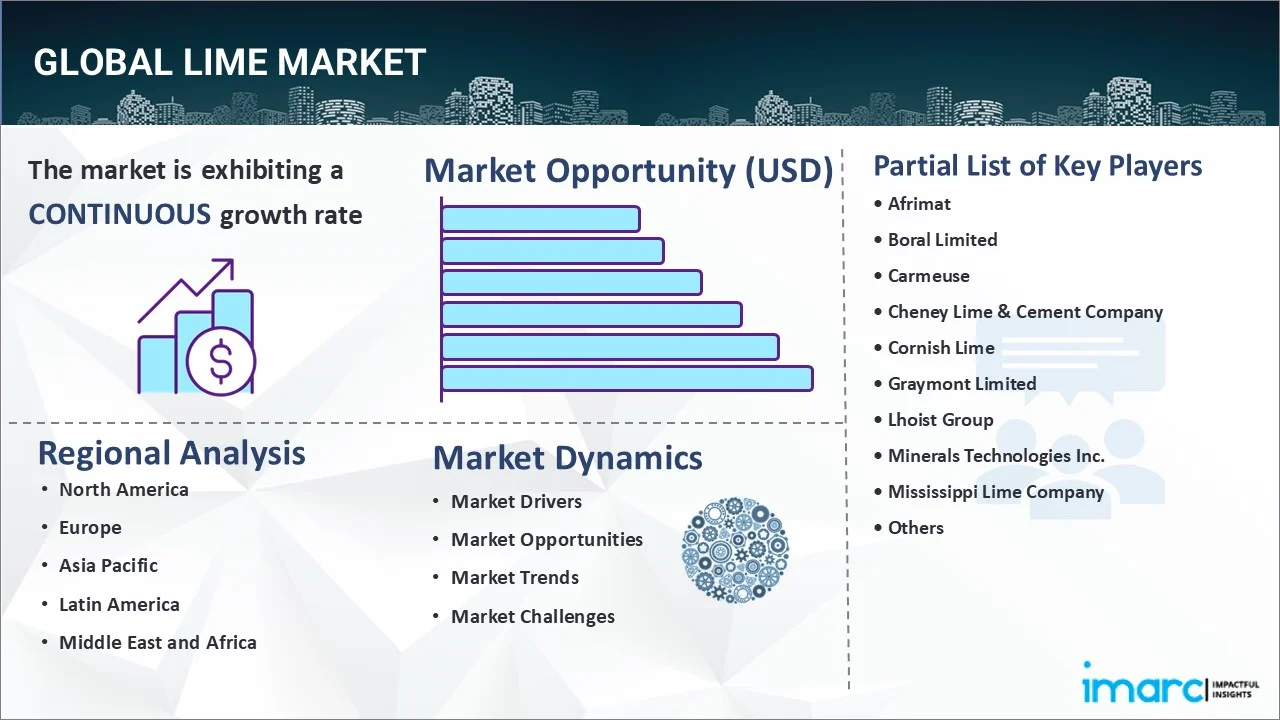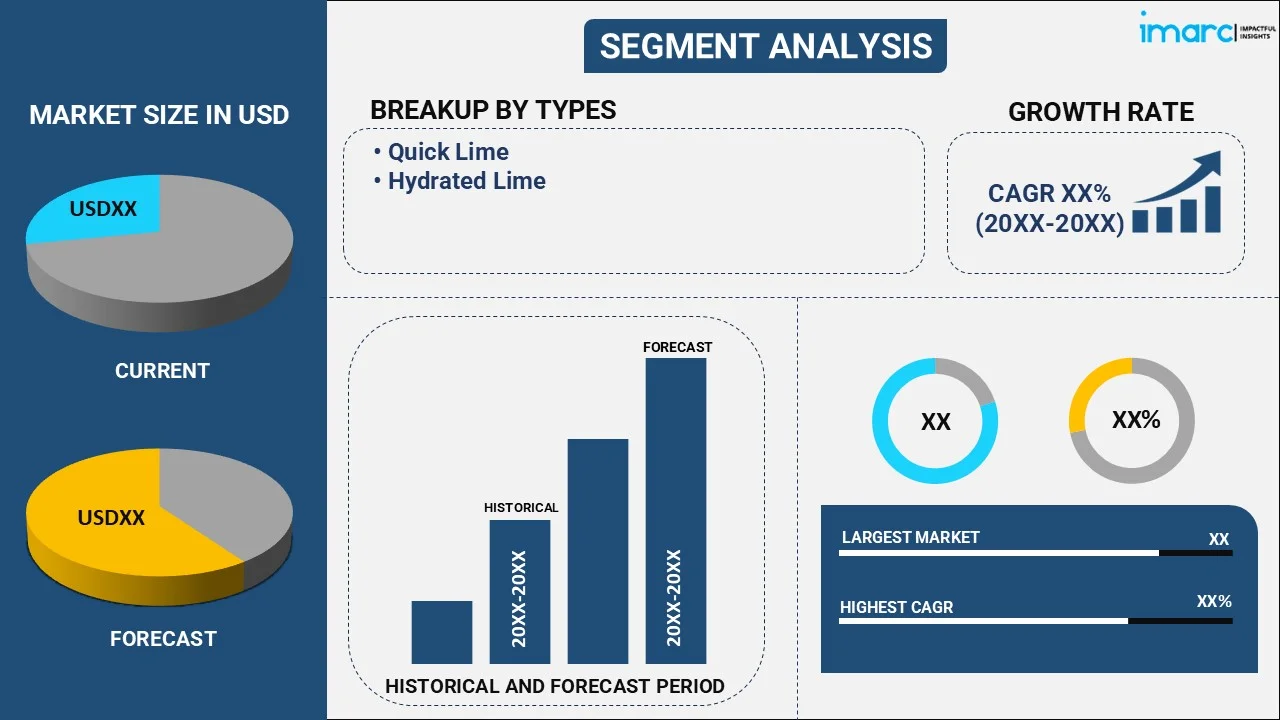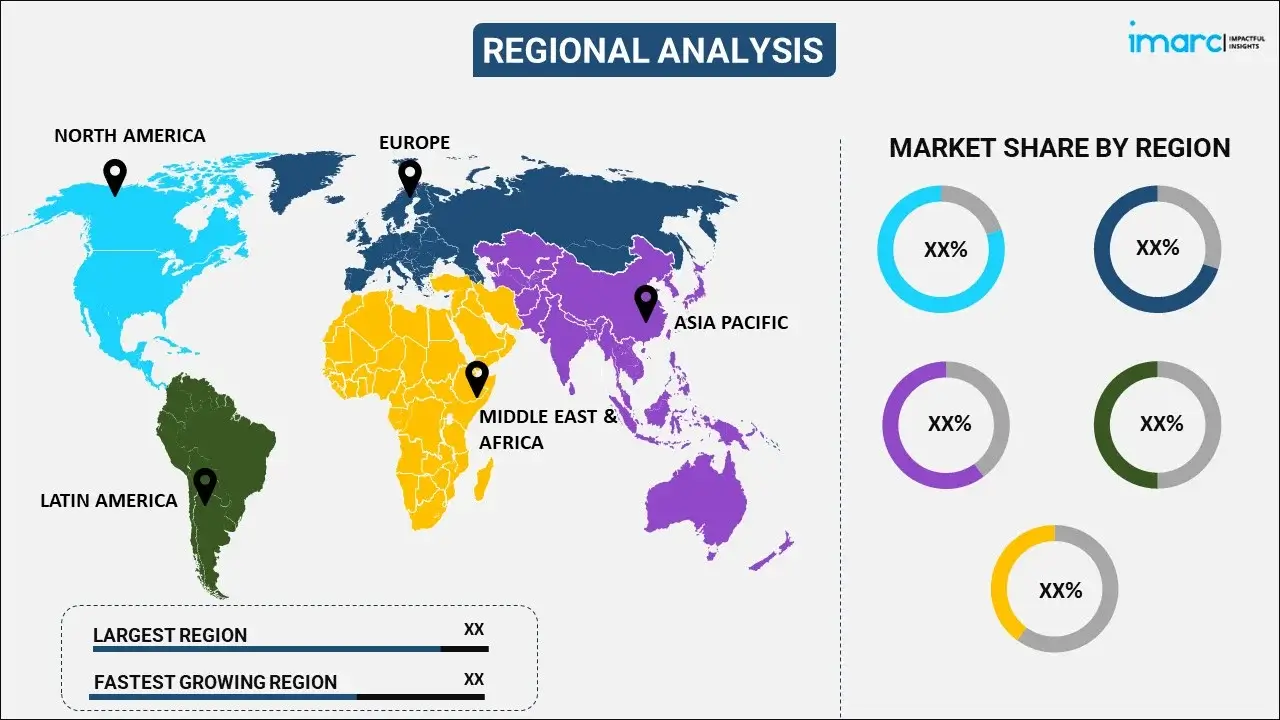
Lime Market Report by Type (Quick Lime, Hydrated Lime), Application (Agriculture, Building Material, Mining and Metallurgy, Water Treatment, and Others), and Region 2025-2033
Global Lime Market:
The global lime market size reached USD 47.8 Billion in 2024. Looking forward, IMARC Group expects the market to reach USD 64.8 Billion by 2033, exhibiting a growth rate (CAGR) of 3.43% during 2025-2033. The rapid growth of the construction industry, the elevating focus on sustainable construction practices, the escalating investments in infrastructure projects, and continuous technological advancements in production processes are some of the major factors propelling the market.
|
Report Attribute
|
Key Statistics
|
|---|---|
|
Base Year
|
2024 |
|
Forecast Years
|
2025-2033
|
|
Historical Years
|
2019-2024
|
| Market Size in 2024 | USD 47.8 Billion |
| Market Forecast in 2033 | USD 64.8 Billion |
| Market Growth Rate 2025-2033 | 3.43% |
Lime Market Analysis:
- Major Market Drivers: The expanding construction industry, the elevating urbanization levels in developing countries, the introduction of favorable government policies encouraging the utilization of lime in agricultural practices, and technological advancements aimed at enhancing the quality and performance of construction lime are among the key drivers propelling the market growth.
- Key Market Trends: The rising number of infrastructure projects, the advent of smart cities, the growing awareness towards the importance of sustainable practices in construction, and the development of new-age lime production processes that reduce carbon footprint and also optimize yields are the key market trends.
- Competitive Landscape: Some of the major market players in the lime market include Afrimat, Boral Limited, Carmeuse, Cheney Lime & Cement Company, Cornish Lime, Graymont Limited, Lhoist Group, Minerals Technologies Inc., Mississippi Lime Company, Nordkalk Corporation (SigmaRoc plc), Pete Lien & Sons Inc., Sigma Minerals Limited and United States Lime & Minerals Inc., among many others.
- Geographical Trends: As per the lime market overview, Asia Pacific exhibits a clear dominance of the lime market, owing to rapid economic growth, expanding urbanization, and infrastructure development, which are propelling the demand for construction materials, including lime-based products.
- Challenges and Opportunities: The implementation of stringent environmental regulations in some countries regulating the production of lime, the escalating levels of competition between industry players, and the depletion of high-quality limestone, which is reducing the prevalence of raw material sources, are among the major market challenges. Moreover, the fluctuating product demand, on account of macroeconomic factors affecting end-use sectors, such as steel, iron, construction, etc., is also of growing concern. Meanwhile, the rising investments in infrastructure development, the increasing focus on waste management, especially in the water sector, and various technological advancements in lime production processes are the key opportunities that will affect the lime market outlook.

Lime Market Trends:
Rapid Growth of the Construction Industry
The expanding construction industry across countries is naturally propelling the demand for construction materials, including lime. Lime is the crucial ingredient utilized in various construction applications, such as masonry work, plastering, and rendering, owing to its binding and stabilizing properties. This is further compounded by the emerging trends of smart cities, revamping existing cities, and building altogether new ones. For example, Egypt is building a “New Administrative Capital”, along with five others. Iraq has announced similar plans. India is proposing the construction of eight new urban settlements. Ninety-one cities have been announced in the past decade, with 15 in the past year alone. These trends will only escalate in the coming years, on account of the elevating urbanization levels, especially in developing countries as such, the rising number of infrastructure projects, residential and commercial constructions, and renovation activities across the globe are a key trend in the lime market.
Emerging Sustainable Construction Practices
Lime is recognized as an environmental-friendly material, owing to its recyclability and reusability. It is also considered to be more eco-friendly than concrete, as it has a much lower carbon footprint and levels of embodied energy (the total energy consumed in the lifespan of a material). With increasing awareness of sustainable building practices, lime is becoming a preferred choice for construction projects. Its eco-friendly properties align with the goal of reducing environmental impact and promoting long-term sustainability. It also allows for reduced waste generation and provides an eco-conscious solution for builders and developers seeking eco-friendly construction materials. Therefore, construction companies across the globe are adopting lime in their processes. For example, Portuguese construction firm Critical Concrete is using lime in workshop flooring, making tiles, and manufacturing hempcrete and woodcrete as well. There are examples among start-ups as well. For instance, Boston-based Sublime Systems blends lime with silica using alternative methods that consume less energy and are thus more eco-friendly.
Continuous Technological Advancements
The advent of improved production techniques, such as advanced kiln designs and automated processes, has enhanced the efficiency and quality of lime production. For example, lime companies in Rajasthan, India, are pursuing numerous innovative practices, including digitalization of the supply chain, electric arc furnaces, basic oxygen furnaces, secondary refining, and incorporating artificial intelligence to optimize work processes to reduce emissions from the lime production process. These advancements have resulted in higher yields, improved product consistency, and reduced energy consumption, making lime production more cost-effective. Additionally, advancements in logistics and transportation have facilitated the timely and efficient delivery of lime to construction sites, reducing lead times and increasing customer satisfaction. Furthermore, technological innovations have enabled the development of lime-based products with enhanced properties, expanding its applications in various industries.
Lime Market Segmentation:
IMARC Group provides an analysis of the key trends in each segment of the global lime market report, along with forecasts at the global, regional, and country levels for 2025-2033. Our report has categorized the market based on the type and application.
Breakup by Type:

- Quick Lime
- Hydrated Lime
Quick lime dominates the market
The report has provided a detailed breakup and lime market analysis based on the type. This includes quick lime and hydrated lime. According to the report, quick lime represented the largest segment.
Quicklime, also known as calcium oxide, plays a significant role in propelling the lime market. It is a highly versatile and widely used chemical compound in construction materials, such as cement, concrete, and mortar, where it acts as a binding agent. It is also utilized in the steel industry for the production of high-quality steel and steel-related products and as a fluxing agent to remove impurities, such as silica, phosphorus, and sulfur, from iron ore during the steelmaking process. The alkaline properties of quicklime make it valuable for wastewater treatment, soil stabilization, and pH regulation in industrial processes. Moreover, the growing construction and steel industries, along with the increasing demand for water treatment solutions, are accelerating its adoption rate across the globe.
Breakup by Application:
- Agriculture
- Building Material
- Mining and Metallurgy
- Water Treatment
- Others
Building material holds the largest share in the lime industry
A detailed breakup of the lime market statistics based on the application has also been provided in the report. This includes agriculture, building material, mining and metallurgy, water treatment, and others. According to the report, building material accounted for the largest market share.
Lime has been used as a building material for centuries owing to its numerous beneficial properties and advantages. Lime, in various forms such as quicklime and hydrated lime, serves as a fundamental component in manufacturing cement, mortar, and plaster. These lime-based materials provide binding, strength, and durability to structures. It is also utilized in the production of autoclaved aerated concrete (AAC), a lightweight building material with excellent thermal insulation properties. Additionally, lime is used for soil stabilization, improving the properties of weak or expansive soils for construction purposes. Moreover, it allows for easier application and shaping, making it suitable for intricate or curved architectural details. It also accommodates slight movements and settlement in the building, reducing the risk of cracking or damage.
Breakup by Region:

- North America
- United States
- Canada
- Europe
- Germany
- France
- United Kingdom
- Italy
- Spain
- Others
- Asia Pacific
- China
- Japan
- India
- South Korea
- Australia
- Indonesia
- Others
- Latin America
- Brazil
- Mexico
- Others
- Middle East and Africa
Asia Pacific exhibits a clear dominance, accounting for the largest lime market share
The report has also provided a comprehensive analysis of all the major regional markets, which include North America (the United States and Canada); Europe (Germany, France, the United Kingdom, Italy, Spain, and others); Asia Pacific (China, Japan, India, South Korea, Australia, Indonesia, and others); Latin America (Brazil, Mexico, and others); and the Middle East and Africa. According to the report, Asia Pacific holds the leading position in the market.
Asia Pacific is a significant driver of the lime market due to several factors. The region's rapid economic growth, urbanization, and infrastructure development create a strong demand for construction materials, including lime-based products. The expanding manufacturing sector, particularly in steel production and cement manufacturing, is escalating the need for lime as a key ingredient. Moreover, lime is widely used in water treatment processes to adjust pH levels, remove impurities, and enhance water quality. The increasing awareness about water pollution issues and the implementation of stricter regulations are increasing the utilization of lime in water treatment facilities. For example, in 2023 Vietnam’s National Assembly enacted the Law on Water Resources to modernize processes to purify water for citizens. Furthermore, with rapid industrialization and the establishment of manufacturing facilities across various sectors, lime finds applications in chemicals, pulp and paper, and sugar refining industries in the Asia Pacific region.
Competitive Landscape:
The key players in the global lime market are actively engaged in expanding their production capacities and cultivating lime orchards to meet the increasing demand. These players are investing in research and development to develop new lime varieties and improve cultivation techniques. They are also establishing strong distribution networks to ensure efficient supply chain management. Apart from this, the marketing initiatives, such as advertising campaigns, product promotions, and participation in trade shows, help create awareness and drive consumer demand.
The report has provided a comprehensive analysis of the competitive landscape in the global lime market. Detailed profiles of all major companies have also been provided. Some of the key players in the market include:
- Afrimat
- Boral Limited
- Carmeuse
- Cheney Lime & Cement Company
- Cornish Lime
- Graymont Limited
- Lhoist Group
- Minerals Technologies Inc.
- Mississippi Lime Company
- Nordkalk Corporation (SigmaRoc plc)
- Pete Lien & Sons Inc.
- Sigma Minerals Limited
- United States Lime & Minerals Inc.
(Please note that this is only a partial list of the key players, and the complete list is provided in the report.)
Lime Market News:
- 2023: The global lime market price registered fluctuations throughout the year, on account of weak buying momentum in China and a downturn in the iron and steel sector in Germany.
- 2023: Nordkalk Corporation acquired a majority shareholding of Juuan Dolomiittikalkki Oy, a company that specializes in the production or supply of dolomitic limestone or related products, in order to expand its presence or diversifying its product portfolio in the dolomitic limestone market.
- December 2022: VTT announced that it has developed an electric rotary kiln for environmentally friendly cement production. Powered by low-emission electricity, this kiln enables the capturing of pure CO2 when lime is burned in the pre-calcination phase of cement production.
Lime Market Report Scope:
| Report Features | Details |
|---|---|
| Base Year of the Analysis | 2024 |
| Historical Period | 2019-2024 |
| Forecast Period | 2025-2033 |
| Units | Billion USD |
| Scope of the Report | Exploration of Historical Trends and Market Outlook, Industry Catalysts and Challenges, Segment-Wise Historical and Future Market Assessment:
|
| Types Covered | Quick Lime, Hydrated Lime |
| Applications Covered | Agriculture, Building Material, Mining and Metallurgy, Water Treatment, Others |
| Regions Covered | Asia Pacific, Europe, North America, Latin America, Middle East and Africa |
| Countries Covered | United States, Canada, Germany, France, United Kingdom, Italy, Spain, China, Japan, India, South Korea, Australia, Indonesia, Brazil, Mexico |
| Companies Covered | Afrimat, Boral Limited, Carmeuse, Cheney Lime & Cement Company, Cornish Lime, Graymont Limited, Lhoist Group, Minerals Technologies Inc., Mississippi Lime Company, Nordkalk Corporation (SigmaRoc plc), Pete Lien & Sons Inc., Sigma Minerals Limited, United States Lime & Minerals Inc.,etc. |
| Customization Scope | 10% Free Customization |
| Post-Sale Analyst Support | 10-12 Weeks |
| Delivery Format | PDF and Excel through Email (We can also provide the editable version of the report in PPT/Word format on special request) |
Key Questions Answered in This Report:
- How has the global lime market performed so far, and how will it perform in the coming years?
- What are the drivers, restraints, and opportunities in the global lime market?
- What is the impact of each driver, restraint, and opportunity on the global lime market?
- What are the key regional markets?
- Which countries represent the most attractive lime market?
- What is the breakup of the market based on the type?
- Which is the most attractive type in the lime market?
- What is the breakup of the market based on the application?
- Which is the most attractive application in the lime market?
- What is the competitive structure of the global lime market?
- Who are the key players/companies in the global lime market?
Key Benefits for Stakeholders:
- IMARC’s industry report offers a comprehensive quantitative analysis of various market segments, historical and current market trends, market forecasts, and dynamics of the Lime market from 2019-2033.
- The research report provides the latest information on the market drivers, challenges, and business opportunities in the global Lime market.
- The study maps the leading, as well as the fastest-growing, regional markets. It further enables stakeholders to identify the key country-level markets within each region.
- Porter's five forces analysis assists stakeholders in assessing the impact of new entrants, competitive rivalry, supplier power, buyer power, and the threat of substitution. It helps stakeholders to analyze the level of competition within the Lime industry and its attractiveness.
- The competitive landscape allows stakeholders to understand their competitive environment and provides insight into the current positions of key players in the market.
Need more help?
- Speak to our experienced analysts for insights on the current market scenarios.
- Include additional segments and countries to customize the report as per your requirement.
- Gain an unparalleled competitive advantage in your domain by understanding how to utilize the report and positively impacting your operations and revenue.
- For further assistance, please connect with our analysts.
 Inquire Before Buying
Inquire Before Buying
 Speak to an Analyst
Speak to an Analyst
 Request Brochure
Request Brochure
 Request Customization
Request Customization




.webp)




.webp)












